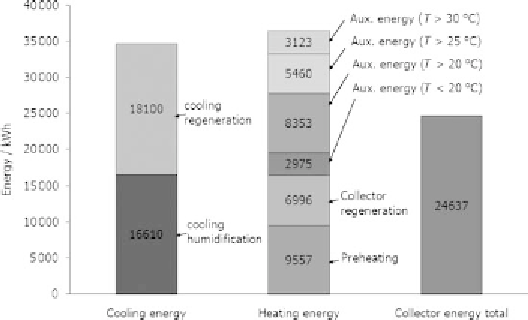Environmental Engineering Reference
In-Depth Information
air was heated to a maximum and consumed a high amount of energy. In July, the
problems were solved and the system was working properly. In August, the operating
time of the system was low due to summer vacations. In September, the auxiliary
heating system was disconnected, so that pure solar and waste heat operation took
place. Due to the limited regeneration air temperatures, the average COP was very
high. Even when the heating energy is only related to full desiccant cooling operation,
the COP is 1.5. This demonstrates the benefit on the performance results of allowing
low-temperature regeneration.
During thewhole operation periodmore than half of the cooling energywas obtained
with full desiccant operation; for the rest of the operating time the humidificationmode
was sufficient. From the total required heating energy of 36 460 kWh only 6996 kWh
was covered by the solar air collector field, and a further 9557 kWh was provided
by the preheater from machine waste heat. More than half of the required heating
energy came from an auxiliary heater. However, the solar air collector heating energy
was used to a large extent for heating the old production hall, which was required
throughout the summer, so that the total collector thermal energy yield from march to
September was 24 637 kWh (see Figure 5.30).
It is interesting that about 30% of the auxiliary energy is spent when the out-
side temperatures are rather low (2975 kWh for outside temperatures below 20
◦
C
and 8353 kWh for temperatures between 20 and 25
◦
C). Although the temperature
reduction between the outside air and inlet air is small for these conditions, the
dehumidification process requires a high amount of energy. Auxiliary cooling would
be preferable under such conditions. If this is not possible, the controller must ensure
that the regeneration air temperature is kept at its minimum and not set to fixed values.
Figure 5.30
Complete energy balance for the Althengstett desiccant cooling unit. The auxiliary energy
is split into different ambient air temperature ranges. The cooling energy is separated into full regeneration
mode and humidification mode only

Search WWH ::

Custom Search